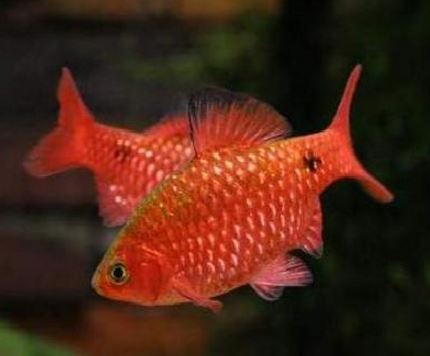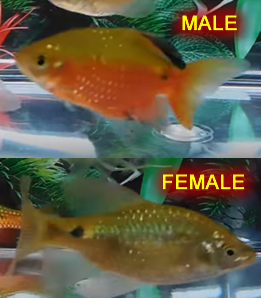
-

Rosy Barb Male & Female Rosy Barbs are a terrific addition to the aquarium. The vivid colours of male and females makes them an attractive option that is also hardy and relatively peaceful if kept in large enough groups.
Common Name(s) : Rosy Barb
Family : Cyprinidae
Genus: Puntius
Species : Puntius conchonius
Origin : Bengal, India
PH : 6.5 – 7.5
Hardness : Soft to Hard
Temperature : 18 – 28°C / 64–82°F
Maximum Size : 15cm / 6 inches
Lifespan : 5 years
Aggression Level : Low-Medium (3.5/10)
Recommended Tank Size : 30 Litres +
Strata : Visits all areas
DESCRIPTION
The Rosy Barb has a torpedo-shaped body, two dorsal fins (a characteristic of all the Cyprinid fishes) and a forked tail. Rosy Barb’s can reach 6 inches (15 cm) in the wild, though they generally only reach about 4 inches (10 cm) in the aquarium.
The general colouration is yellow to pinkish with a greenish cast along the back. Males are a more reddish colour, especially on the underbelly and sides. There is a black spot just in front of the caudal peduncle, and there may be some black along the top margins of the anal and dorsal fins. She is also plumper than the more elongated male.
Rosy Barb’s colour becomes bolder during spawning. Rosy Barbs are mature at 2.5 inches.
TANK SET UP
Provide rocks, large pieces of driftwood, live or fake plants etc for lots of cover
SUITABLE TANK MATES
- Angelfish
- Dwarf Cichlids
- Bristlenose
- Corydoras
- Danios
- Siamese Flying Fox
- Loaches
- Mollies
- Platys
- Rainbows
- Rasboras
- Sharks
- Silver Dollars
- Snails
- Swordtails
- Tetras
DIET
Omnivores – Frozen, Live, Flakes, Pellets, Vegetables
SEXING AND BREEDING
Rosy Barbs will readily breed in an aquarium. To successfully breed Rosy Barbs you might like to set up a separate densely planted tank and after the eggs have been scattered (usually 200 to 300 of them!!) the adults should be removed as Rosy Barbs have a tendency to eat their own eggs. Live plants such as Java Moss, Wisteria, even Ambulia are great suggestions for this purpose.
When the female Rosy Barb is ready to spawn, she will appear swollen (or “gravid”) with eggs. The males will circle and chase the females, repeatedly nudging her head and belly area. Eggs are usually deposited in groups of plants, and the pair will attempt to eat any that they are able to locate. For this reason it is suggested both parents be removed as they do not feature any maternal instincts.
The young hatch in 24 to 36 hours, depending on water temperature. The eggs will hatch in one to two days and the fry are free-swimming after two more days. The fry and can be fed frozen baby brine shrimp. After five weeks, the fry will be about 1 cm long.
OTHER USEFUL INFORMATION
Rosy Barbs do enjoy a densely planted aquarium. They can be a shy fish and will enjoy the cover of a canopy.
